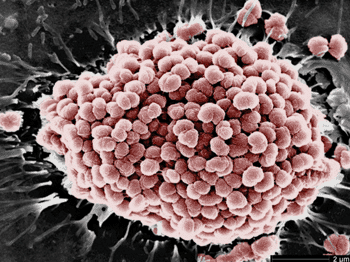Combined Biosensor Strategy Detects Infectious Pathogens
By LabMedica International staff writers
Posted on 14 Jun 2013
A method has been developed that combines deoxyribozyme technology with gold nanoparticles to give a simple point-of-care (POC) diagnostic technique that can be used in remote settings.Posted on 14 Jun 2013
The technique merges the colorimetric coupling of surface plasmons of gold nanoparticles (GNPs) with deoxyribozyme (DNAzyme) signal amplification technology to create a fast and simple detection method for genetic targets with a simple colorimetric readout.

Image: Neisseria gonorrhoeae infection of human epithelial cells (Photo courtesy of Dr. Magdalene So).
Chemical engineers at the University of Toronto (ON, Canada) implemented a genetic sensing assay in a simple two-step system. In the amplification step, a buffered mix of multicomponent nucleic acid enzymes (MNAzymes) and linkers is added to the sample solution and incubated at 50 °C for one hour. If target sequences are present, they bind and activate the MNAzymes. Each active MNAzyme in turn catalyzes cleavage of multiple linkers, which effectively translates into signal amplification.
Any linkers that remained uncleaved caused aggregation of the corresponding GNP pairs, turning the solution purple. In contrast, linkers cleaved by target-activated MNAzymes were not able to cross-link the associated GNP pairs, and solution remained red. In one test for the pathogen Neisseria gonorrhoeae, the mixtures in the specific detection tubes remained red. Following this method, the scientist successfully detected five targets simultaneously. In addition, the assay with lyophilized components was used to correctly identify gonorrhea, malaria, and hepatitis B virus sequences in a sample mixture that contained three out of the five targets. All RNA-containing Linker DNA strands were obtained from Integrated DNA Technologies (Coralville, IA, USA) in purified lyophilized form and all other DNA sequences were from BioBasic (Markham, ON, Canada).
The authors concluded that the assay can detect multiple genetic sequences in parallel and that it could be easily applied to other nucleic acid targets. The color-based readout does not require any complex equipment and uses stable and cost-effective reagents, making this approach particularly suitable for POC testing. Warren C. W. Chan, PhD, a professor in nanobiotechnology and the senior author, said, “There's been a lot of emphasis in developing simple diagnostics. The question is how do you make it simple enough, portable enough? Gold is the best medium, because it's easy to see. It emits a very intense color." The article was published on March 11, 2013, in the journal Angewandte Chemie.
Related Links:
University of Toronto
Integrated DNA Technologies
BioBasic









 assay.jpg)



